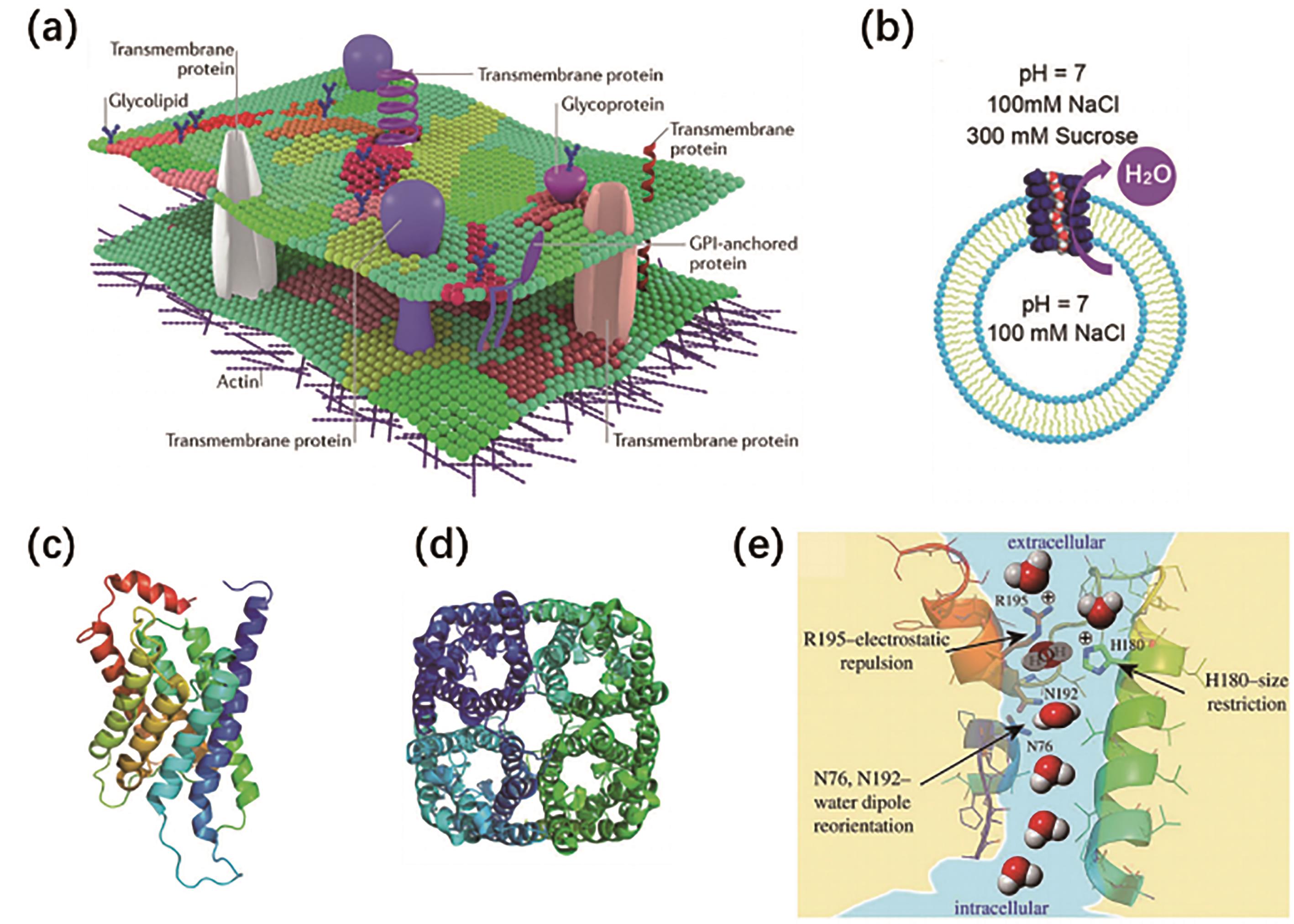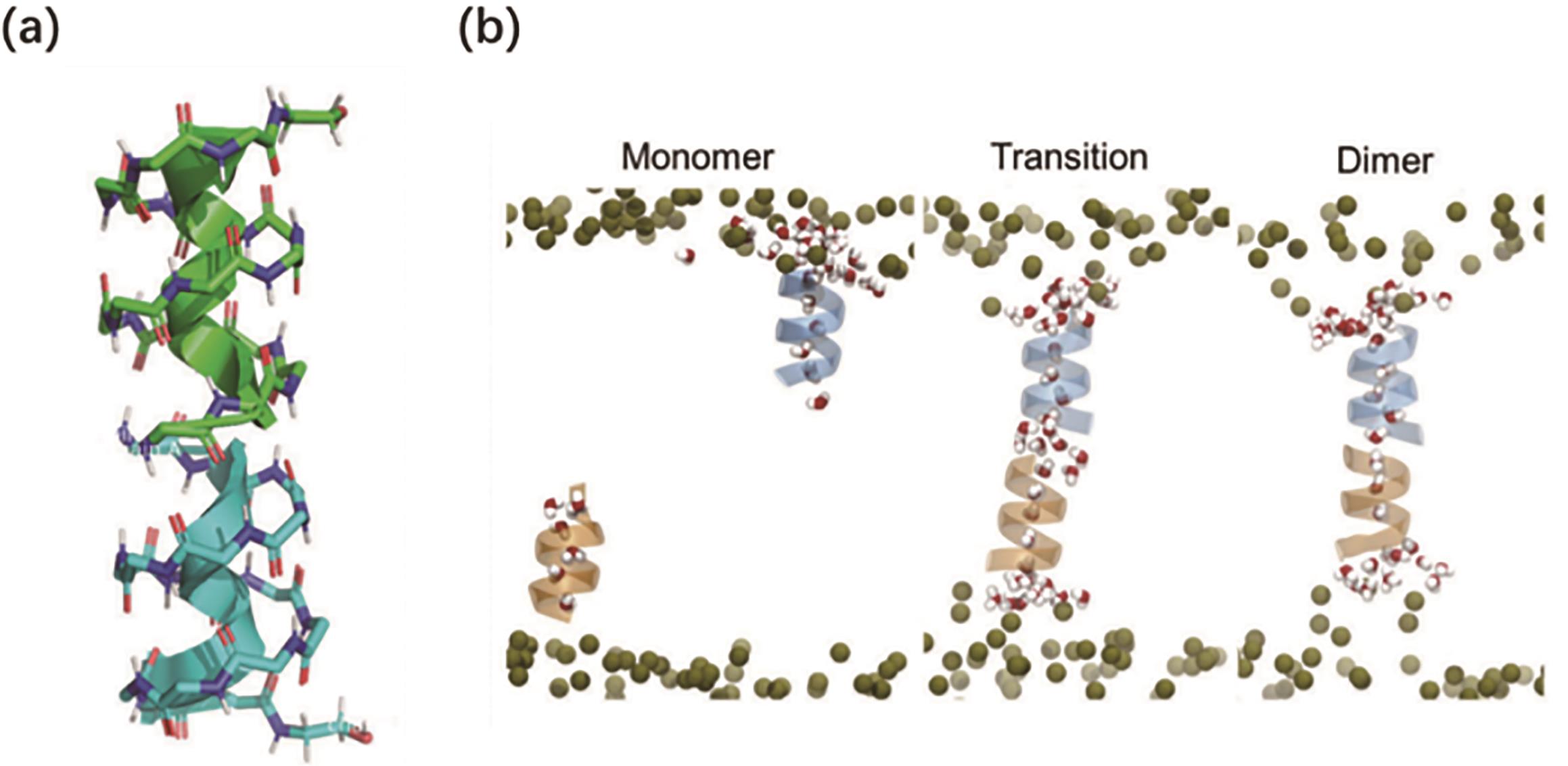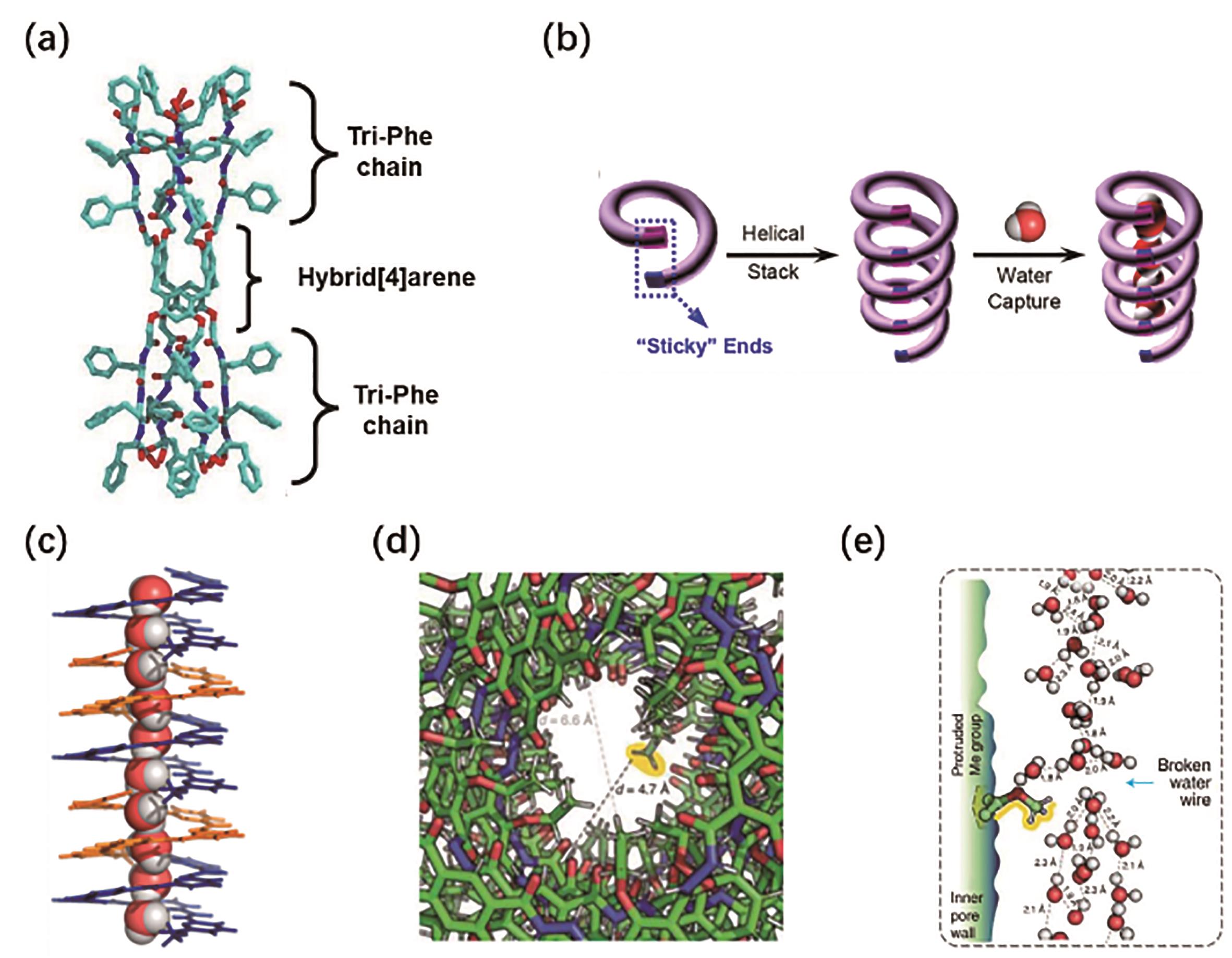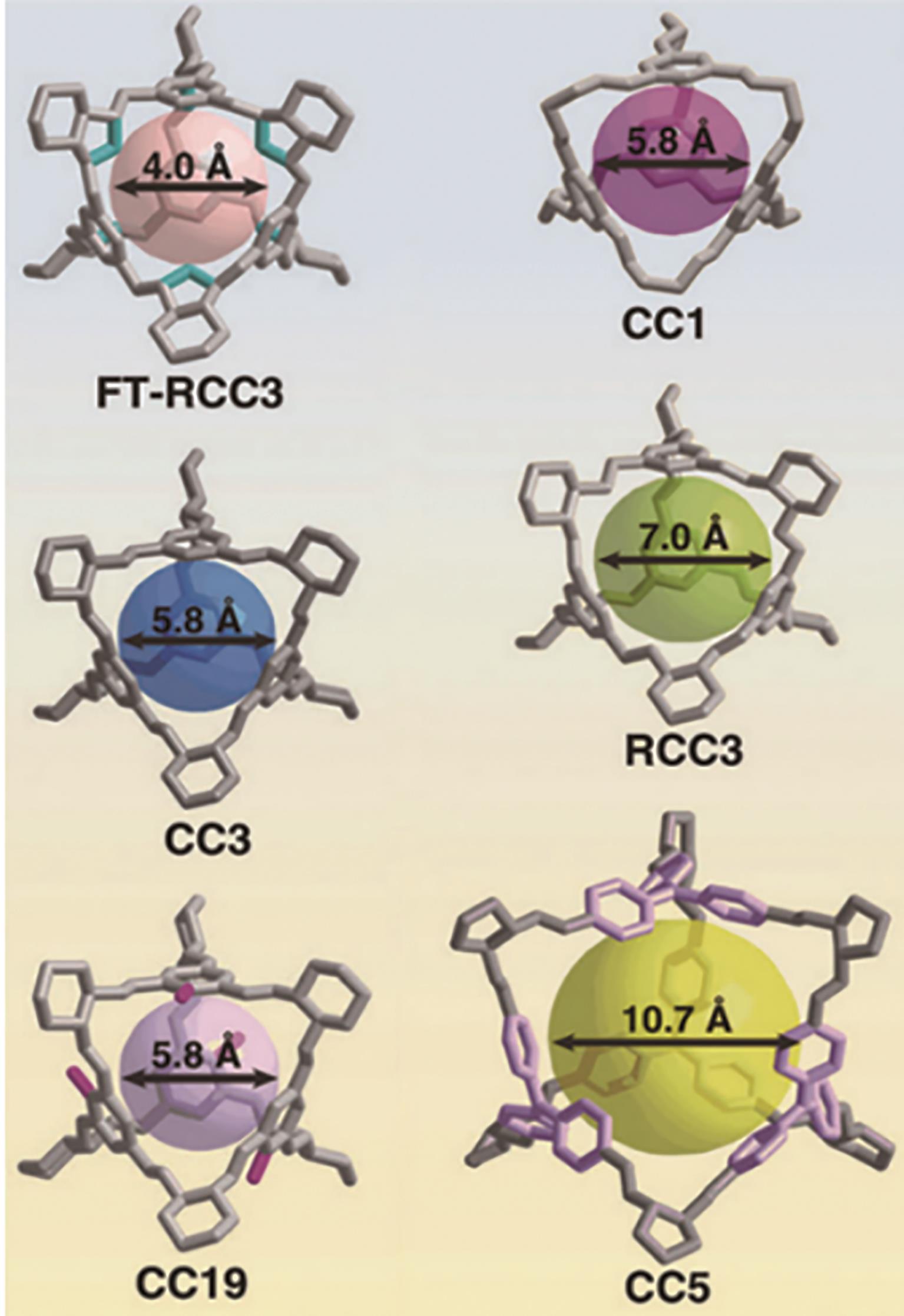
Chinese Journal of Applied Chemistry ›› 2023, Vol. 40 ›› Issue (9): 1245-1257.DOI: 10.19894/j.issn.1000-0518.230025
• Review • Previous Articles Next Articles
Research Progress in Designing Artificial Water Channels Based on Aquaporin
Dao-Zhen CHENG1, Zhen-Ran WANG2, Hua-Yuan SHANGGUAN3,4( )
)
- 1.College of Bioresources Chemical and Materials Engineering,Shaanxi University of Science and Technology,Xi'an 710021,China
2.Faculty of Geosciences and Environmental Engineering,Southwest Jiaotong University,Chengdu 611756,China
3.Institute of Urban Environment,Chinese Academy of Sciences,Xiamen 361021,China
4.University of Chinese Academy of Sciences,Beijing 100049,China
-
Received:2023-02-15Accepted:2023-07-13Published:2023-09-01Online:2023-09-14 -
Contact:Hua-Yuan SHANGGUAN -
About author:hyshangguan@iue.ac.cn
CLC Number:
Cite this article
Dao-Zhen CHENG, Zhen-Ran WANG, Hua-Yuan SHANGGUAN. Research Progress in Designing Artificial Water Channels Based on Aquaporin[J]. Chinese Journal of Applied Chemistry, 2023, 40(9): 1245-1257.
share this article
Add to citation manager EndNote|Ris|BibTeX
URL: http://yyhx.ciac.jl.cn/EN/10.19894/j.issn.1000-0518.230025

Fig.1 (a) Schematic diagram of various components in the cell membrane, mainly consisting of lipids and transmembrane protein channels[7]; (b) Schematic diagram of water transport through water channels embedded in liposomes[8]; (c) Side view of Aquaporin-1 (AQP1) (hourglass shape)[9]; (d) AQP1 tetramer[9]; (e) Water transport pattern in AQP1 (amino acid distribution in the inner wall of AQP1 channel)[2]

Fig.2 (a) β-Helix formed by folding of gramicidin A (gA) [9]; (b) Schematic representation of the orientation of water molecules in the three cases of gA monomer, transition state and after gA dimer formation[9,13]
| Name | Type | Hydrophilicity | Diameter/? | Modified or not | Polar or charged group | Permeability (H2O/s/channel) | Selectivity | Distortion | Large area integration | Ref. |
|---|---|---|---|---|---|---|---|---|---|---|
| 4-LA | Single-molecule | Hydrophobic | 3~6.5 | Yes | Yes | 2.7×1010 | Only Water | No | No | [ |
| Aquafoldmer-1 | Single-molecule | Hydrophilic | 2.8 | No | No | 3×109 | Only Water | No | No | [ |
| PAH[ | Single-molecule | Hydrophobic | 3~5 | No | No | 3.7×109 | Water and Proton | No | No | [ |
| PAPs | Self-assembly | Unreported | 5 | No | No | 3.5×108 | Water and Proton | No | No | [ |
| AQP1 | Protein | Mixed | 2.8 | No | Yes | 3×109~4×109 | Only Water | Yes | No | [ |
| gA | Protein | Mixed | 40 | No | Yes | 5.3×108 | Water and Ions | Yes | No | [ |
| Zwitterionic | Self-assembly | Hydrophilic | 2.6 | No | No | Unreported | Water | No | No | [ |
| Porous-DD | Self-assembly | Hydrophobic | 14.5 | No | No | Unreported | Water and Proton | No | No | [ |
| I-Quartet | Self-assembly | Hydrophilic | 2.6 | No | No | Unreported | Water and Proton | No | No | [ |
| PAH4s | Single-molecule | Unreported | Unreported | No | No | Unreported | Water | No | No | [ |
| PAH5s | Single-molecule | Unreported | Unreported | No | No | Unreported | Water | No | No | [ |
| S-HC8 | Single-molecule | Hydrophilic | 2.6 | No | No | 1×106 | Water and Proton | No | No | [ |
| wCNTs | Single-molecule | Hydrophobic | 15 | Yes | Yes | 1.9×109 | Water and Proton | No | Yes | [ |
| nCNTs | Single-molecule | Hydrophobic | 0.8 | Yes | Yes | 2.3×1010 | Water and Proton | No | Yes | [ |
| POCs | Single-molecule | Hydrophilic | 4~10.7 | No | No | 2.85×109 | Water and Proton | No | No | [ |
| F-foldamer | Self-assembly | Hydrophobic | 5.2 | No | No | 1.4×1010 | Only Water | No | No | [ |
Table 1 Comparison of the characteristics of different types of artificial water channels and natural AQPs
| Name | Type | Hydrophilicity | Diameter/? | Modified or not | Polar or charged group | Permeability (H2O/s/channel) | Selectivity | Distortion | Large area integration | Ref. |
|---|---|---|---|---|---|---|---|---|---|---|
| 4-LA | Single-molecule | Hydrophobic | 3~6.5 | Yes | Yes | 2.7×1010 | Only Water | No | No | [ |
| Aquafoldmer-1 | Single-molecule | Hydrophilic | 2.8 | No | No | 3×109 | Only Water | No | No | [ |
| PAH[ | Single-molecule | Hydrophobic | 3~5 | No | No | 3.7×109 | Water and Proton | No | No | [ |
| PAPs | Self-assembly | Unreported | 5 | No | No | 3.5×108 | Water and Proton | No | No | [ |
| AQP1 | Protein | Mixed | 2.8 | No | Yes | 3×109~4×109 | Only Water | Yes | No | [ |
| gA | Protein | Mixed | 40 | No | Yes | 5.3×108 | Water and Ions | Yes | No | [ |
| Zwitterionic | Self-assembly | Hydrophilic | 2.6 | No | No | Unreported | Water | No | No | [ |
| Porous-DD | Self-assembly | Hydrophobic | 14.5 | No | No | Unreported | Water and Proton | No | No | [ |
| I-Quartet | Self-assembly | Hydrophilic | 2.6 | No | No | Unreported | Water and Proton | No | No | [ |
| PAH4s | Single-molecule | Unreported | Unreported | No | No | Unreported | Water | No | No | [ |
| PAH5s | Single-molecule | Unreported | Unreported | No | No | Unreported | Water | No | No | [ |
| S-HC8 | Single-molecule | Hydrophilic | 2.6 | No | No | 1×106 | Water and Proton | No | No | [ |
| wCNTs | Single-molecule | Hydrophobic | 15 | Yes | Yes | 1.9×109 | Water and Proton | No | Yes | [ |
| nCNTs | Single-molecule | Hydrophobic | 0.8 | Yes | Yes | 2.3×1010 | Water and Proton | No | Yes | [ |
| POCs | Single-molecule | Hydrophilic | 4~10.7 | No | No | 2.85×109 | Water and Proton | No | No | [ |
| F-foldamer | Self-assembly | Hydrophobic | 5.2 | No | No | 1.4×1010 | Only Water | No | No | [ |

Fig.3 (a) Molecular model of PAH[4] water channel[18]; (b) Aquafoldamer water channel constructed by the “sticky end” method[8,19]; (c) Single-line transport of water molecules in the Aqf water channel[20]; (d) Local cross-sectional reduction of the water channel due to the inward protrusion of methyl and ethyl groups in the pore wall[5]; (e) Schematic representation of the proton water line breakage due to the protrusion of groups in the pore[5]

Fig.4 (a) Schematic representation of water encapsulated in an amphiphilic polymer channel[29]; (b) Selective transport of water and protons in a porous dendritic dipeptide channel (pore size estimated to be 1.45 nm)[30]; (c) Side view of a self-assembled I-quartet water channel with a quaternary tubular structure[34]; (d) Top view of an I-quartet water channel[39]

Fig.5 (a) Cryogenic transmission electron microscopy (TEM) images showing CNTP inserted in liposomes[43]; (b) Molecular dynamics simulations describe the transport of water molecules in a single water line within narrow CNTPs [35]; (c) TEM images of CPNs aggregated into bundles[44]; (d) General chemical structure of α,γ?-cyclic peptides (left panel) and CPN sandwiched in lipid bilayers (right panel) [45]; (e) Schematic representation of the formation of peptide nanotube channels with nanotube channels through stacks of CPN units of different diameters[45]

Fig.6 Two types of graphene as water channels: (a) Monolayer graphene with nanopores on the basal plane[55], (b) Interlayer-spaced graphene nanosheets with 2D nanotubes[55]; (c) GO nanosheet layers using well-defined interlayer spacing as 2D water channels[56]; (d) Different strategies for adjusting interlayer spacing and widening the channels[57]; (e) New ways to facilitate water transport in GO layers using percolation holes of ZIF-8 nanocrystals as water channels[58]
| 1 | ZHANG Z, WEN L P, JIANG L. Nanofluidics for osmotic energy conversion[J]. Nat Rev Mater, 2021, 6(7): 622-639. |
| 2 | JAKOWIECKI J, SZTYLER A, FILIPEK S, et al. Aquaporin-graphene interface: relevance to point-of-care device for renal cell carcinoma and desalination[J]. Interface Focus, 2018(8): 20170066. |
| 3 | MOSS F J, MAHINTHICHAICHAN P, LODOWSKI D T, et al. Aquaporin-7: a dynamic aquaglyceroporin with greater water and glycerol permeability than its bacterial homolog GlpF[J]. Front Physiol, 2020(11): 728. |
| 4 | TU Y M, SAMINENI L, REN T W, et al. Prospective applications of nanometer-scale pore size biomimetic and bioinspired membranes[J]. J Membrane Sci, 2021, 620: 118968. |
| 5 | ROY A, SHEN J, JOSHI H, et al. Foldamer-based ultrapermeable and highly selective artificial water channels that exclude protons[J]. Nat Nanotechnol, 2021, 16: 911-917. |
| 6 | LI Q, LI X S, NING L L, et al. Hyperfast water transport through biomimetic nanochannels from peptide-attached (pR)- pillar[5]arene[J]. Small, 2019, 15(6): 1804678. |
| 7 | SEZGIN E, LEVENTAL I, MAYOR S, et al. The mystery of membrane organization: composition, regulation and roles of lipid rafts[J]. Nat Rev Mol Cell Bio, 2017(18): 361-374. |
| 8 | SHEN J, YE R, ROMANIES A, et al. Aquafoldmer-based aquaporin-like synthetic water channel[J]. J Am Chem Soc, 2020, 142: 10050-10058. |
| 9 | LIM Y J, GOH K, WANG R. The coming of age of water channels for separation membranes: from biological to biomimetic to synthetic[J]. Chem Soc Rev, 2022, 51(11): 4537-4582. |
| 10 | MURATA K, MITSUOKA K, HIRAI T, et al. Structural determinants of water permeation through aquaporin-1[J]. Nature, 2000, 407(6804): 599-605. |
| 11 | MARX D, TUCKERMAN M E, HUTTER J, et al. The nature of the hydrated excess proton in water[J]. Nature, 1999, 397(6720): 601-604. |
| 12 | SUN D, HE S, BENNETT W, et al. Atomistic characterization of gramicidin channel formation[J]. J Chem Theory Comput, 2021, 17(1): 7-12. |
| 13 | SUN D L, PEYEAR T A, BENNETT W, et al. Molecular mechanism for gramicidin dimerization and dissociation in bilayers of different thickness[J]. Biophys J, 2019, 117(10): 1831-1844. |
| 14 | ABAIE E, XU L, SHEN Y X. Bioinspired and biomimetic membranes for water purification and chemical separation: a review[J]. Front Env Sci Eng, 2021, 15(6): 1-33. |
| 15 | TU Y M, SONG W, REN T W, et al. Rapid fabrication of precise high-throughput filters from membrane protein nanosheets[J]. Nat Mater, 2020, 19(3): 347. |
| 16 | OGOSHI T, SUETO R, YAGYU M, et al. Molecular weight fractionation by confinement of polymer in one-dimensional pillar[5]arene channels[J]. Nat Commun, 2019, 10(1): 1-8. |
| 17 | OGOSHI T, YAMAGISHI T A, NAKAMOTO Y. Pillar-shaped macrocyclic hosts pillar[n]arenes: new key players for supramolecular chemistry[J]. Chem Rev, 2016, 116(14): 7937-8002. |
| 18 | SONG W, JOSHI H, CHOWDHURY R, et al. Artificial water channels enable fast and selective water permeation through water-wire networks[J]. Nat Nanotechnol, 2020, 15(1): 73-79. |
| 19 | HUO Y, ZENG H. “Sticky”-ends-guided creation of functional hollow nanopores for guest encapsulation and water transport[J]. Acc Chem Res, 2016, 49(5): 922-930. |
| 20 | SHEN J, FAN J, YE R, et al. Polypyridine-based helical amide foldamer channels: rapid transport of water and protons with high ion rejection[J]. Angew Chem Int Ed, 2020, 59: 13328-13334. |
| 21 | KHALIL-CRUZ L E, LIU P, HUANG F, et al. Multifunctional pillar[n]arene-based smart nanomaterials[J]. ACS Appl Mater Interfaces, 2021, 13(27): 31337-31354. |
| 22 | ZHANG H, LIU Z, ZHAO Y. Pillararene-based self-assembled amphiphiles[J]. Chem Soc Rev, 2018, 47(14): 5491-5528. |
| 23 | MURRAY J, KIM K, OGOSHI T, et al. The aqueous supramolecular chemistry of cucurbit[n]urils, pillar[n]arenes and deep-cavity cavitands[J]. Chem Soc Rev, 2017, 46(9): 2479-2496. |
| 24 | SHEN Y X, SI W, ERBAKAN M, et al. Highly permeable artificial water channels that can self-assemble into two-dimensional arrays[J]. P Natl Acad Sci USA, 2015, 112(32): 9810-9815. |
| 25 | LIM Y J, GOH K, LAI G S, et al. Fast water transport through biomimetic reverse osmosis membranes embedded with peptide-attached (pR)-pillar[5]arenes water channels[J]. J Membrane Sci, 2021, 628: 119276. |
| 26 | BURYKIN A, WARSHEL A. What really prevents proton transport through aquaporin? charge self-energy versus proton wire proposals[J]. Biophys J, 2003, 85(6): 3696-3706. |
| 27 | DE GROOT B L, GRUBMULLER H. Water permeation across biological membranes: mechanism and dynamics of aquaporin-1 and GlpF[J]. Science, 2001, 294(5550): 2353-2357. |
| 28 | SAPAROV S M, PFEIFER J, AL-MOMANI L, et al. Mobility of a one-dimensional confined file of water molecules as a function of file length[J]. Phys Rev Lett, 2006, 96(14):148101. |
| 29 | FEI Z, ZHAO D, GELDBACH T J, et al. A synthetic zwitterionic water channel: characterization in the solid state by X-ray crystallography and NMR spectroscopy[J]. Angew Chem Int Ed, 2005, 44(35): 5720-5725. |
| 30 | KAUCHER M S, PETERCA M, DULCEY A E, et al. Selective transport of water mediated by porous dendritic dipeptides[J]. J Am Chem Soc, 2007, 129(38): 11698-11699. |
| 31 | LE DUC Y, MICHAU M, GILLES A, et al. Imidazole-quartet water and proton dipolar channels[J]. Angew Chem Int Ed, 2011, 50(48): 11366-11372. |
| 32 | SI W, CHEN L, HU X B, et al. Selective artificial transmembrane channels for protons by formation of water wires[J]. Angew Chem Int Ed, 2011, 50(52): 12564-12568. |
| 33 | HU X B, CHEN Z X, TANG G F, et al. Single-molecular artificial transmembrane water channels[J]. J Am Chem Soc, 2012, 134(20): 8384-8387. |
| 34 | LICSANDRU E, KOCSIS I, SHEN Y X, et al. Salt-excluding artificial water channels exhibiting enhanced dipolar water and proton translocation[J]. J Am Chem Soc, 2016, 138(16): 5403-5409. |
| 35 | TUNUGUNTLA R H, HENLEY R Y, YAO Y C, et al. Enhanced water permeability and tunable ion selectivity in subnanometer carbon nanotube porins[J]. Science, 2017, 357(6353): 792-796. |
| 36 | YUAN Y D, DONG J, LIU J, et al. Porous organic cages as synthetic water channels[J]. Nat Commun, 2020, 11(1): 4927. |
| 37 | SHEN J, ROY A, JOSHI H, et al. Fluorofoldamer-based salt- and proton-rejecting artificial water channels for ultrafast water transport[J]. Nano Lett, 2022, 22(12): 4831-4838. |
| 38 | KONG X, ZHAO Z, JIANG J. Dipeptides embedded in a lipid bilayer membrane as synthetic water channels[J]. Langmuir, 2017, 33(42): 11490-11495. |
| 39 | HUANG L B, Di VINCENZO M, AHUNBAY M G, et al. Bilayer versus polymeric artificial water channel membranes: structural determinants for enhanced filtration performances[J]. J Am Chem Soc, 2021, 143(35): 14386-14393. |
| 40 | KOCSIS I, SORCI M, VANSELOUS H, et al. Oriented chiral water wires in artificial transmembrane channels[J]. Sci Adv, 2018, 4(3): o5603. |
| 41 | ZHANG Z, WEN L, JIANG L. Bioinspired smart asymmetric nanochannel membranes[J]. Chem Soc Rev, 2018, 47(2): 322-356. |
| 42 | GOH K, KARAHAN H E, WEI L, et al. Carbon nanomaterials for advancing separation membranes: a strategic perspective[J]. Carbon, 2016, 109: 694-710. |
| 43 | TUNUGUNTLA R H, ALLEN F I, KIM K, et al. Ultrafast proton transport in sub-1-nm diameter carbon nanotube porins[J]. Nat Nanotechnol, 2016, 11(7): 639-644. |
| 44 | HOURANI R, ZHANG C, VAN DER WEEGEN R, et al. Processable cyclic peptide nanotubes with tunable interiors[J]. J Am Chem Soc, 2011, 133(39): 15296-15299. |
| 45 | FUERTES A, JUANES M, GRANJA J R, et al. Supramolecular functional assemblies: dynamic membrane transporters and peptide nanotubular composites[J]. Chem Commun, 2017, 53(56): 7861-7871. |
| 46 | SANBORN J R, CHEN X, YAO Y C, et al. Carbon nanotube porins in amphiphilic block copolymers as fully synthetic mimics of biological membranes[J]. Adv Mater, 2018, 30(51): e1803355. |
| 47 | LI Y, LI Z, AYDIN F, et al. Water-ion permselectivity of narrow-diameter carbon nanotubes[J]. Sci Adv, 2020, 6(38): a9966. |
| 48 | WANG Q, ZHONG Y, MILLER D P, et al. Self-assembly and molecular recognition in water: tubular stacking and guest-templated discrete assembly of water-soluble, shape-persistent macrocycles[J]. J Am Chem Soc, 2020, 142(6): 2915-2924. |
| 49 | ZHOU X, LIU G, YAMATO K, et al. Self-assembling subnanometer pores with unusual mass-transport properties[J]. Nat Commun, 2012, 3: 949. |
| 50 | WERBER J R, OSUJI C O, ELIMELECH M. Materials for next-generation desalination and water purification membranes[J]. Nat Rev Mater, 2016, 1(5): 16018. |
| 51 | PORTER C J, WERBER J R, ZHONG M, et al. Pathways and challenges for biomimetic desalination membranes with sub-nanometer channels[J]. ACS Nano, 2020, 14(9): 10894-10916. |
| 52 | LIU G, JIN W, XU N. Graphene-based membranes[J]. Chem Soc Rev, 2015, 44(15): 5016-5030. |
| 53 | PERREAULT F, FONSECA D F A, ELIMELECH M. Environmental applications of graphene-based nanomaterials[J]. Chem Soc Rev, 2015, 44(16): 5861-5896. |
| 54 | DONG L, YANG J, CHHOWALLA M, et al. Synthesis and reduction of large sized graphene oxide sheets[J]. Chem Soc Rev, 2017, 46(23): 7306-7316. |
| 55 | SUN P Z, YANG Q, KUANG W J, et al. Limits on gas impermeability of graphene[J]. Nature, 2020, 579(7798): 229-232. |
| 56 | ABRAHAM J, VASU K S, WILLIAMS C D, et al. Tunable sieving of ions using graphene oxide membranes[J]. Nat Nanotechnol, 2017, 12(6): 546-550. |
| 57 | CHEN X, WANG H. Graphene oxide patchwork membranes[J]. Nat Nanotechnol, 2021, 16(3): 226-227. |
| 58 | ZHANG W H, YIN M J, ZHAO Q, et al. Graphene oxide membranes with stable porous structure for ultrafast water transport[J]. Nat Nanotechnol, 2021, 16(3): 337-343. |
| 59 | NAIR R R, WU H A, JAYARAM P N, et al. Unimpeded permeation of water through helium-leak-tight graphene-based membranes[J]. Science, 2012, 335(6067): 442-444. |
| 60 | KEERTHI A, GOUTHAM S, YOU Y, et al. Water friction in nanofluidic channels made from two-dimensional crystals[J]. Nat Commun, 2021, 12(1): 3092. |
| 61 | ZHENG S, TU Q, URBAN J J, et al. Swelling of graphene oxide membranes in aqueous solution: characterization of interlayer spacing and insight into water transport mechanisms[J]. ACS Nano, 2017, 11(6): 6440-6450. |
| 62 | JOSHI R K, CARBONE P, WANG F C, et al. Precise and ultrafast molecular sieving through graphene oxide membranes[J]. Science, 2014, 343(6172): 752-754. |
| 63 | SUN P, WANG K, ZHU H. Recent developments in graphene-based membranes: structure, mass-transport mechanism and potential applications[J]. Adv Mater, 2016, 28(12): 2287-2310. |
| 64 | YANG E, HAM M H, PARK H B, et al. Tunable semi-permeability of graphene-based membranes by adjusting reduction degree of laminar graphene oxide layer[J]. J Membrane Sci, 2018, 547: 73-79. |
| 65 | SUI X, YUAN Z W, LIU C, et al. Graphene oxide laminates intercalated with 2D covalent-organic frameworks as a robust nanofiltration membrane[J]. J Mater Chem A, 2020, 8(19): 9713-9725. |
| 66 | HUNG W S, LIN T J, CHIAO Y H, et al. Graphene-induced tuning of the d-spacing of graphene oxide composite nanofiltration membranes for frictionless capillary action-induced enhancement of water permeability[J]. J Mater Chem A, 2018, 6(40): 19445-19454. |
| 67 | CHUAH C Y, GOH K, YANG Y Q, et al. Harnessing filler materials for enhancing biogas separation membranes[J]. Chem Rev, 2018, 118(18): 8655-8769. |
| 68 | DING M, FLAIG R W, JIANG H L, et al. Carbon capture and conversion using metal-organic frameworks and MOF-based materials[J]. Chem Soc Rev, 2019, 48(10): 2783-2828. |
| 69 | LIU R, TAN K T, GONG Y, et al. Covalent organic frameworks: an ideal platform for designing ordered materials and advanced applications[J]. Chem Soc Rev, 2021, 50(1): 120-242. |
| 70 | YUAN S, LI X, ZHU J, et al. Covalent organic frameworks for membrane separation[J]. Chem Soc Rev, 2019, 48(10): 2665-2681. |
| 71 | WANG Z, ZHANG S, CHEN Y, et al. Covalent organic frameworks for separation applications[J]. Chem Soc Rev, 2020, 49(3): 708-735. |
| 72 | HASELL T, COOPER A I. Porous organic cages: soluble, modular and molecular pores[J]. Nat Rev Mater, 2016, 1(9): 16053. |
| 73 | CHOWDHURY R, REN T, SHANKLA M, et al. Pore designer for tuning solute selectivity in a robust and highly permeable outer membrane pore[J]. Nat Commun, 2018, 9(1): 3661. |
| 74 | LIM Y J, GOH K, KURIHARA M, et al. Seawater desalination by reverse osmosis: current development and future challenges in membrane fabricatio? a review[J]. J Membrane Sci, 2021, 629: 119292. |
| 75 | LIU G L, ZHOU B, LIU J W, et al. The bionic water channel of ultra-short, high affinity carbon nanotubes with high water permeability and proton selectivity[J]. Sustainability, 2021, 13(1): 102. |
| [1] | Qi-Hang CHEN, Fei-Jian XU, Feng WANG, Shuang-Chan FU, Ying-Hao YU. Research Progress of Deep Eutectic Solvent and Its Application Prospects as Antistatic Agents [J]. Chinese Journal of Applied Chemistry, 2023, 40(3): 341-359. |
| [2] | HUAI Meng-Jiao, LIU Tao-Xue-Ting, JIANG Zhong-Yi. Research Progress of Artificial Water Channels Inspired by Aquaporin [J]. Chinese Journal of Applied Chemistry, 2022, 39(1): 99-109. |
| [3] | HU Jiale, XUE Dongfeng. Research Progress on the Characteristics of Rare Earth Ions and Rare Earth Functional Materials [J]. Chinese Journal of Applied Chemistry, 2020, 37(3): 245-255. |
| [4] | HUI Kanglong, FU Jipeng, GAO Tian, TANG Mingxue. Research Progress of Metal Sulfides in Rechargeable Batteries [J]. Chinese Journal of Applied Chemistry, 2020, 37(12): 1384-1402. |
| [5] | XIE Fei,WEI Zhixian. Advances on Tetrazole-1-acetic Acid-Based Metal Coordination Polymers [J]. Chinese Journal of Applied Chemistry, 2017, 34(10): 1099-1109. |
| [6] | GUO Rui, SAI Mingze, ZHANG Min, ZHONG Shiliang, MA Wentao, CHEN Lei, DING Derun. Preparation and Performance of Chitosan Grafted Polyvinyl Pyrrolidone Film with Iodine [J]. Chinese Journal of Applied Chemistry, 2015, 32(5): 498-503. |
| [7] | LIU Xufeng*, CHENG Zhenxian. Hydroaminaton of C60 and its application to preparation of C60-containing functional materials [J]. Chinese Journal of Applied Chemistry, 2011, 28(12): 1343-1353. |
| Viewed | ||||||
|
Full text |
|
|||||
|
Abstract |
|
|||||
